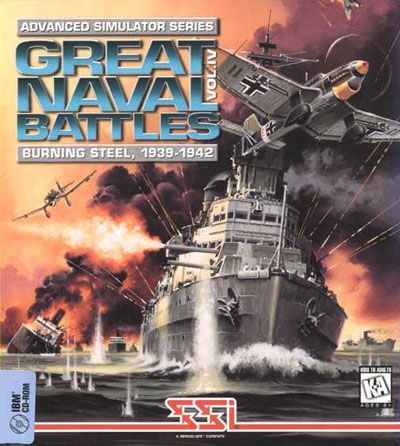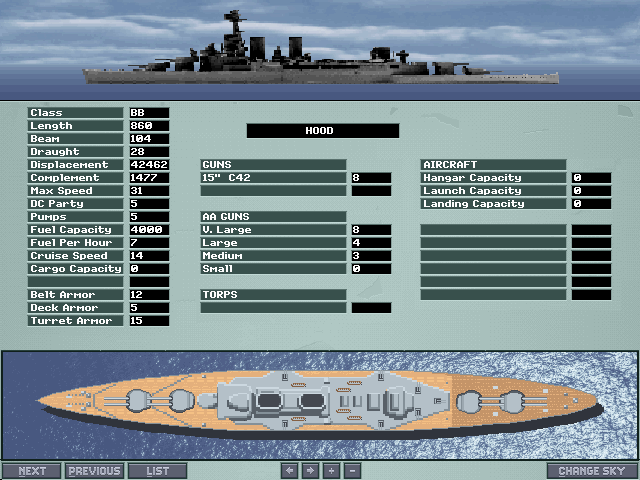Retro Replay Review
Gameplay
Great Naval Battles Vol. IV: Burning Steel, 1939-1942 delivers a deeply engaging naval warfare simulation that puts you at the helm of warships in the European theater of World War II. The core gameplay revolves around meticulously planning and executing fleet maneuvers against enemy forces. Whether you opt for quick skirmishes or dive into one of the many independent scenarios, the tension of surface warfare is captured in both broad strategic decisions and the fine details of gunnery control.
(HEY YOU!! We hope you enjoy! We try not to run ads. So basically, this is a very expensive hobby running this site. Please consider joining us for updates, forums, and more. Network w/ us to make some cash or friends while retro gaming, and you can win some free retro games for posting. Okay, carry on 👍)
One of the standout features is the scenario editor, which allows you to deploy up to 50 ships per side. This editor gives you unprecedented creative freedom, from recreating hypothetical clashes in the North Sea to forging daring Soviet flotilla raids in the Baltic. The ability to mix and match ships and set environmental conditions means virtually endless replay value, and veteran players will find themselves returning to refine their own creations.
The interface strikes a careful balance between realism and accessibility. Ship controls, targeting interfaces, damage models, and tactical maps require a short learning curve but quickly reward diligence. While die-hard simulation fans will appreciate the granular control over speed, heading, and fire solutions, newcomers may find the system demanding at first. Fortunately, built-in tutorials and adjustable AI difficulty help smooth the learning process.
Replayability is at the heart of Burning Steel’s design. Alternate, non-historical missions—such as commanding a Russian task force against the Kriegsmarine—offer fresh challenges that break free from recorded history. These “what-if” scenarios, combined with the option to play the rare historically accurate battles, create an engaging mix that keeps both casual players and hardcore strategists invested over the long haul.
Graphics
Visually, Burning Steel reflects its early 1990s heritage while still delivering a surprisingly detailed representation of naval combat. Ship sprites are well-defined, with visible superstructures, gun turrets, and funnel details that bring each vessel class to life. The color palette captures the gray, muted tones of northern European waters and overcast skies, adding to the atmosphere of tense engagements.
Water rendering, though simple by modern standards, uses clever shading and wave animations to suggest sea state and weather conditions. Splash effects, wake trails, and smoke plumes from gunfire and funnel exhausts add dynamic elements that make each skirmish feel alive. Occasional fog or twilight lighting further tests your visibility and tactical decision-making.
The tactical map view and user interface elements—arrowed icons, concentric range circles, and ship status overlays—prioritize function over flash. While there are no 3D models or high-resolution textures, the clarity of information presentation ensures you never lose track of your fleet’s formation or an enemy’s approach vector. The scenario editor’s map tools, in particular, feel intuitive and responsive.
Performance is smooth on period-appropriate hardware and can be comfortably emulated on modern machines. Loading times are minimal, and frame rates remain stable even when dozens of ships exchange broadsides. Though graphically dated compared to contemporary titles, Burning Steel’s visuals effectively support its strategic focus and never distract from the core gameplay.
Story
Burning Steel forgoes a traditional narrative campaign in favor of discrete scenarios that each tell their own micro-stories of maritime conflict. You won’t find cutscenes or character arcs, but each mission brief evokes historical context or imaginative “what-if” settings. From a dawn sortie of British destroyers probing German minefields to a bold Soviet cruiser task force pushing into the Baltic, every engagement feels purposeful.
The emphasis on alternate missions allows players to step into roles rarely covered by other war games of its era. Commanding the Russian navy against a surprised Axis escort, for instance, flips expectations and encourages creative tactics. Though these missions lack elaborate scripting, the emergent narratives—ships crippled and limping for port, desperate night engagements under moonlight—are compelling in their own right.
When you opt for historically accurate battles, the game provides concise but informative background details, highlighting order of battle, mission objectives, and known strategic challenges. While you don’t get character-driven storytelling, the sense of participating in a larger conflict gives each mission weight. The minimal presentation style allows players to fill in the drama through their own experiences on the waves.
Perhaps the greatest narrative strength lies in the scenario editor, which serves as a sandbox for your personal naval sagas. By placing ships, setting weather patterns, and adjusting victory conditions, you craft situations that can surprise even seasoned admirals. These custom scenarios often generate stories far richer than scripted campaigns, as unpredictable AI maneuvers and player choices combine to produce unique outcomes.
Overall Experience
Great Naval Battles Vol. IV: Burning Steel, 1939-1942 stands as a testament to classic computer wargaming. It prioritizes strategic depth and simulation authenticity over flashy graphics or cinematic storytelling. While its steep learning curve and dated visuals may deter some, those willing to invest time will discover a richly detailed naval combat experience with immense longevity.
The combination of independent and alternate scenarios alongside a powerful ship editor means that no two sessions feel the same. Whether you’re reenacting a historical clash or scripting a daring raid of your own design, Burning Steel provides the tools and mechanics to bring your vision to life. The game’s pacing—measured and deliberate—captures the tension of wartime cat-and-mouse games on the high seas.
This title is best suited for enthusiasts of naval history and strategy fans who appreciate methodical gameplay. If you enjoy poring over tables of ship statistics, plotting engagement arcs, and fine-tuning fire solutions, this volume of Great Naval Battles will reward you for every earnest effort. Casual players seeking immediate action or cinematic thrills may find its pace too slow, but simulation purists will celebrate its authenticity.
In sum, Burning Steel offers a deep, flexible, and engaging simulation of World War II surface warfare. Its scenario variety, editor capabilities, and tactical richness combine to form a package that remains impressive decades after its release. For those eager to test their mettle as a fleet admiral, this game remains a worthy command.
 Retro Replay Retro Replay gaming reviews, news, emulation, geek stuff and more!
Retro Replay Retro Replay gaming reviews, news, emulation, geek stuff and more!








Reviews
There are no reviews yet.